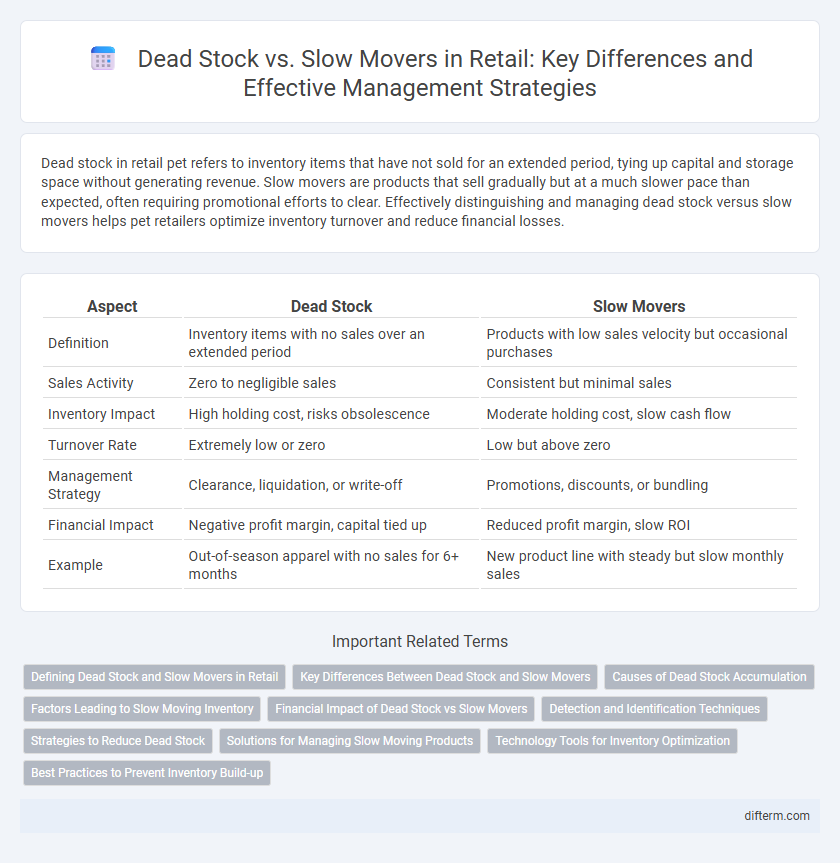Dead stock in retail pet refers to inventory items that have not sold for an extended period, tying up capital and storage space without generating revenue. Slow movers are products that sell gradually but at a much slower pace than expected, often requiring promotional efforts to clear. Effectively distinguishing and managing dead stock versus slow movers helps pet retailers optimize inventory turnover and reduce financial losses.
Table of Comparison
| Aspect | Dead Stock | Slow Movers |
|---|---|---|
| Definition | Inventory items with no sales over an extended period | Products with low sales velocity but occasional purchases |
| Sales Activity | Zero to negligible sales | Consistent but minimal sales |
| Inventory Impact | High holding cost, risks obsolescence | Moderate holding cost, slow cash flow |
| Turnover Rate | Extremely low or zero | Low but above zero |
| Management Strategy | Clearance, liquidation, or write-off | Promotions, discounts, or bundling |
| Financial Impact | Negative profit margin, capital tied up | Reduced profit margin, slow ROI |
| Example | Out-of-season apparel with no sales for 6+ months | New product line with steady but slow monthly sales |
Defining Dead Stock and Slow Movers in Retail
Dead stock in retail refers to inventory items that have not sold and remain unsold for an extended period, often due to lack of demand or obsolescence. Slow movers are products that sell at a significantly lower rate compared to other items, causing prolonged storage but still generating occasional sales. Identifying and distinguishing these inventory categories is crucial for optimizing stock levels and improving cash flow.
Key Differences Between Dead Stock and Slow Movers
Dead stock refers to inventory items that have not sold for an extended period and show little to no demand, often leading to full write-offs and increased holding costs. Slow movers are products with low but consistent sales velocity, requiring strategic markdowns or targeted promotions to improve turnover without immediately resorting to clearance. Understanding these distinctions helps retailers optimize inventory management, reduce obsolescence, and enhance cash flow efficiency.
Causes of Dead Stock Accumulation
Dead stock accumulation in retail often stems from inaccurate demand forecasting, resulting in excess inventory that fails to sell. Poor product lifecycle management and seasonal items left unsold contribute significantly to inventory stagnation. Ineffective marketing strategies and changing consumer preferences also lead to slow movers turning into dead stock, increasing holding costs and reducing profitability.
Factors Leading to Slow Moving Inventory
Slow moving inventory in retail often results from inaccurate demand forecasting, which leads to overstocking products with low customer interest. Another critical factor is poor product assortment planning, where inventory does not align well with current market trends or consumer preferences. Ineffective marketing strategies and lack of promotions can also reduce product visibility, causing items to remain unsold longer.
Financial Impact of Dead Stock vs Slow Movers
Dead stock ties up significant capital and storage space without generating revenue, leading to increased holding costs and reduced cash flow in retail operations. Slow movers, while selling less frequently, still contribute to sales and can be liquidated over time, mitigating prolonged financial drain. Efficient inventory management that minimizes dead stock and optimizes the turnover of slow movers enhances profitability and improves working capital utilization.
Detection and Identification Techniques
Effective detection of dead stock and slow movers relies on advanced inventory analytics using sales velocity and turnover rates to identify items with prolonged shelf time. Implementing automated SKU performance monitoring systems enables real-time tracking of slow-moving products by analyzing historical sales data and seasonal trends. Visual inspection combined with machine learning algorithms enhances accuracy in distinguishing between dead stock, which shows no sales over extended periods, and slow movers with transient reduced demand.
Strategies to Reduce Dead Stock
Implementing demand forecasting and inventory management software helps retailers identify slow-moving products early, enabling timely markdowns or promotions to stimulate sales. Utilizing data-driven liquidation strategies such as bundling or flash sales reduces dead stock while freeing up valuable shelf space. Collaborating with suppliers for return or exchange programs further minimizes the financial impact of unsold inventory and supports continuous product turnover.
Solutions for Managing Slow Moving Products
Implementing dynamic pricing strategies and targeted promotions effectively reduces slow-moving inventory by increasing product appeal and clearing stock faster. Utilizing predictive analytics enhances demand forecasting accuracy, allowing retailers to optimize inventory levels and minimize dead stock accumulation. Integrating real-time inventory management systems supports timely decision-making, ensuring that slow movers are identified early and addressed with tailored marketing efforts.
Technology Tools for Inventory Optimization
Technology tools such as advanced inventory management systems and AI-driven analytics enable retailers to accurately identify dead stock and slow movers by analyzing sales velocity and demand patterns. Implementing RFID tracking and real-time data dashboards improves stock visibility, helping businesses optimize reorder points and reduce holding costs. Machine learning algorithms forecast product trends, allowing retailers to adjust inventory strategies proactively and minimize excess stock accumulation.
Best Practices to Prevent Inventory Build-up
Implementing real-time inventory tracking and demand forecasting helps distinguish dead stock from slow movers, enabling timely adjustments to purchasing strategies. Regularly analyzing sales data and customer trends ensures inventory aligns with market demand, preventing excess accumulation. Collaborating with suppliers for flexible order quantities and employing promotional strategies targets slow-moving items, reducing the risk of costly dead stock build-up.
Dead Stock vs Slow Movers Infographic

 difterm.com
difterm.com